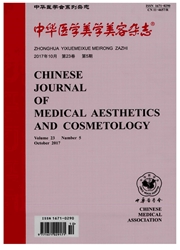

 中文摘要:
中文摘要:
目的探讨血管内皮祖细胞(endothelial progenitor cell,EPC)移植促进游离移植的脂肪颗粒组织的血管新生,提高移植脂肪颗粒组织存活率。方法体外分离、培养人脐血中EPCs,然后与来自人体的脂肪颗粒组织混合移植于裸鼠背部。结果脐血中分离培养的EPCs表达血管内皮细胞生长因子受体(KDR)及细胞表面标记CD34、CD133,EPCs与脂肪颗粒组织混合移植到裸鼠3个月后,EPCs整合到缺血部位新生血管中,与对照组的脂肪颗粒组织存活率分别为(89.3±6.8)%、(42.2±2.5)%(P〈0.05),而且实验组与对照组脂肪颗粒组织周边区毛细血管密度差异有统计学意义(P〈0.05)。术后3个月2组脂肪颗粒组织周边区的EPCs密度分别为(95.2±10.5)个/mm^2、0个/mm^2(P%O.05)。结论体外培养的脐血EPCs移植体内可促进游离移植的脂肪颗粒组织的血管新生,提高存活率。
 英文摘要:
英文摘要:
Objective To investigate the feasibility of transplanted endothelial progenitor cells (EPCs) to increase free transplanted fat tissue with increased neovascularization and augmented survival volume. Methods EPCs were isolated from human cord blood, cultured in vitro and identified by immunocytochemistry. Then EPCs were transplanted into free transplanted fat tissue at 9 nude mice's back (experimental group), and 9 nude mice transplanted with free fat tissue were injected with M199 (control group). CM-DiI was used to trace the transplanted cells. The capillary density of transplantation fat tissue was detected by CD34 immunohistochemistry 3 months after operation. Results EPCs expressed cell markers CD34, KDR and CD133. After transplantation EPCs survived and proliferated, and transplanted EPCs were incorporated into the capillary networks in the transplanted fat tissue. The percent of experimental group's transplanted fat tissue survival volume was (89.3 ±6.8)%, significantly higher than the control group (P〈0.05). The capillary density of transplanted fat tissue in the experimental group was significantly higher than the control group (P〈0.05). Conclusions EPCs from human cord blood can increase free transplanted fat tissue neovascularization and augment the survival volume.
 同期刊论文项目
同期刊论文项目
 同项目期刊论文
同项目期刊论文
 期刊信息
期刊信息
